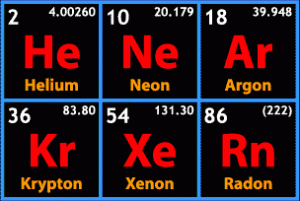What is a safe and acceptable level of radon gas?
This is actually two separate questions. The first is: “What is a safe level of radon gas?” The second is: “What is an acceptable level of radon gas?”
Atomic Data for Radon (Rn) Atomic Number = 86 Atomic Weight = (222) Reference E95: Isotope: Mass: Abundance: Spin: Mag Moment: 219 Rn: 219.009479. Radon is an element with atomic symbol Rn, atomic number 86, and 222.0. The three naturally occurring radon isotopes (222Rn, 220Rn, and 219Rn) with half-lives varying over 3 orders of magnitude are useful as tracers in many branches of geoscience.
- Notes on the properties of Radon: Atomic Mass: Atomic mass number given for longest lived isotope. Density: Density at 0° Celsius. Specific Heat: Value given for gas phase. Up to date, curated data provided by Mathematica's ElementData function from Wolfram Research, Inc.
- Our radon page has over 160 facts that span 54 different quantities. Each entry has a full citation identifying its source. Areas covered include atomic structure, physical properties, atomic interaction, thermodynamics, identification, atomic size, history, abundances, and nomenclature.
What is a safe level of radon gas?
Radon Atomic Numbers
This is the simpler of the two questions. A safe level of radon gas is no radon gas. Radon gas is a carcinogen which causes lung cancer. The US EPA has put it plainly, stating, “Any radon exposure has some risk of causing lung cancer. The lower the radon level in your home, the lower your family’s risk of lung cancer.” The average person receives a higher dose of radiation from the radon levels in their home than from their combined exposure to all other radiation sources, natural or man-made. Radon gas is a naturally-occurring byproduct of the radioactive decay of Uranium in the soil. Depending on your geographic location, the radon levels of the air you breathe outside of your home may be as high as 0.75 pCi/L. The national average of outside radon levels is 0.4 pCi/L and it is estimated by the National Academy of Sciences that outdoor radon levels cause approximately 800 of the 21,000 radon induced lung cancer deaths in the US each year. Your risk of lung cancer increases substantially with exposure to higher radon levels. Lung cancer risk rises 16% per 2.7 pCi/L increase in radon exposure. World Health Organization, 2009 studies show that radon is the primary cause of lung cancer among people who have never smoked. However, the absolute numbers of radon-induced lung cancers are much larger in people who smoke, or who have smoked in the past, due to a strong combined effect of smoking and radon.
What is an acceptable level of radon gas?
Imperator: rome - magna graecia content pack. Radon Act 51 passed by Congress set the natural outdoor level of radon gas (0.4 pCi/L) as the target radon level for indoor radon levels. Unfortunately two-thirds of all homes exceed this level. The US EPA was tasked with setting practical guidelines and recommendations for the nation. To this end, the US EPA has set an action level of 4 pCi/L. At or above this level of radon, the EPA recommends you take corrective measures to reduce your exposure to radon gas. This does not imply that a level below 4.0 pCi/L is considered acceptable, as stated in the BEIR VI study . It is estimated that a reduction of radon levels to below 2 pCi/L nationwide would likely reduce the yearly lung cancer deaths attributed to radon by 50%. However, even with an action level of 2.0 pCi/L, the cancer risk presented by radon gas is still hundreds of times greater than the risks allowed for carcinogens in our food and water.
The World Health Organization
The WHO Handbook on Indoor Radon: A Public Health Perspective indicates that radon exposure is a major and growing public health threat in homes and recommends that countries adopt reference levels of the gas of 100 Bq/m3 which is equivalent to 2.7 pCi/L.
Rn Atomic Mass

You can download a PDF version of the WHO handbook on indoor radon here. Warhammer® 40,000: dawn of war® ii chaos rising download. “Radon is the second most important cause of lung cancer after smoking in many countries,” notes Dr Maria Neira, Director of WHO’s Public Health and Environment Department. “Most of radon-induced lung cancers occur from low and medium dose exposures in people’s homes. Strengthened action by policy makers, and by construction and building professionals can substantially lower the health impact by preventing and reducing radon exposure.”
Conclusion
Radon Number Of Protons
While no level of radon gas is completely safe, as with most things in life we must balance the benefits and costs to find our own“acceptable” levels. We walk outside and work in the sun, exposing ourselves to ultraviolet radiation and increasing our risk of developing skin cancer. We drive in automobiles almost every day even though greater than 1 in 86 deaths is a result of automobile accidents. People smoke, eat poorly, and engage in dangerous behaviors on a daily basis. To some degree, radon gas is another daily risk that we all must take. However, you choose what you eat, whether or not you smoke, and how and when you drive. You have no choice but to breathe the air in your home. A simple and inexpensive radon test can give you the information you need to make an informed decision about what level of radon gas exposure is acceptable to you.
